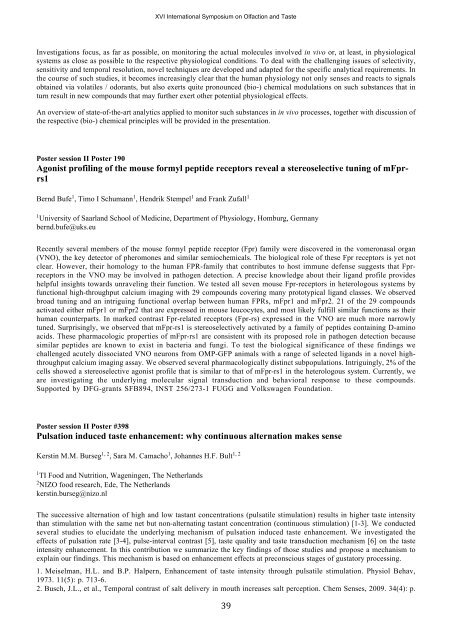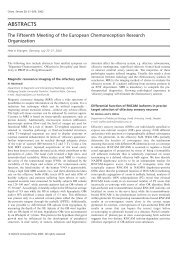XVI International Symposium on Olfaction and Taste - ecro
XVI International Symposium on Olfaction and Taste - ecro
XVI International Symposium on Olfaction and Taste - ecro
You also want an ePaper? Increase the reach of your titles
YUMPU automatically turns print PDFs into web optimized ePapers that Google loves.
<str<strong>on</strong>g>XVI</str<strong>on</strong>g> <str<strong>on</strong>g>Internati<strong>on</strong>al</str<strong>on</strong>g> <str<strong>on</strong>g>Symposium</str<strong>on</strong>g> <strong>on</strong> Olfacti<strong>on</strong> <strong>and</strong> <strong>Taste</strong><br />
Investigati<strong>on</strong>s focus, as far as possible, <strong>on</strong> m<strong>on</strong>itoring the actual molecules involved in vivo or, at least, in physiological<br />
systems as close as possible to the respective physiological c<strong>on</strong>diti<strong>on</strong>s. To deal with the challenging issues of selectivity,<br />
sensitivity <strong>and</strong> temporal resoluti<strong>on</strong>, novel techniques are developed <strong>and</strong> adapted for the specific analytical requirements. In<br />
the course of such studies, it becomes increasingly clear that the human physiology not <strong>on</strong>ly senses <strong>and</strong> reacts to signals<br />
obtained via volatiles / odorants, but also exerts quite pr<strong>on</strong>ounced (bio-) chemical modulati<strong>on</strong>s <strong>on</strong> such substances that in<br />
turn result in new compounds that may further exert other potential physiological effects.<br />
An overview of state-of-the-art analytics applied to m<strong>on</strong>itor such substances in in vivo processes, together with discussi<strong>on</strong> of<br />
the respective (bio-) chemical principles will be provided in the presentati<strong>on</strong>.<br />
Poster sessi<strong>on</strong> II Poster 190<br />
Ag<strong>on</strong>ist profiling of the mouse formyl peptide receptors reveal a stereoselective tuning of mFprrs1<br />
Bernd Bufe 1 , Timo I Schumann 1 , Hendrik Stempel 1 <strong>and</strong> Frank Zufall 1<br />
1University of Saarl<strong>and</strong> School of Medicine, Department of Physiology, Homburg, Germany<br />
bernd.bufe@uks.eu<br />
Recently several members of the mouse formyl peptide receptor (Fpr) family were discovered in the vomer<strong>on</strong>asal organ<br />
(VNO), the key detector of pherom<strong>on</strong>es <strong>and</strong> similar semiochemicals. The biological role of these Fpr receptors is yet not<br />
clear. However, their homology to the human FPR-family that c<strong>on</strong>tributes to host immune defense suggests that Fpr-<br />
receptors in the VNO may be involved in pathogen detecti<strong>on</strong>. A precise knowledge about their lig<strong>and</strong> profile provides<br />
helpful insights towards unraveling their functi<strong>on</strong>. We tested all seven mouse Fpr-receptors in heterologous systems by<br />
functi<strong>on</strong>al high-throughput calcium imaging with 29 compounds covering many prototypical lig<strong>and</strong> classes. We observed<br />
broad tuning <strong>and</strong> an intriguing functi<strong>on</strong>al overlap between human FPRs, mFpr1 <strong>and</strong> mFpr2. 21 of the 29 compounds<br />
activated either mFpr1 or mFpr2 that are expressed in mouse leucocytes, <strong>and</strong> most likely fulfill similar functi<strong>on</strong>s as their<br />
human counterparts. In marked c<strong>on</strong>trast Fpr-related receptors (Fpr-rs) expressed in the VNO are much more narrowly<br />
tuned. Surprisingly, we observed that mFpr-rs1 is stereoselectively activated by a family of peptides c<strong>on</strong>taining D-amino<br />
acids. These pharmacologic properties of mFpr-rs1 are c<strong>on</strong>sistent with its proposed role in pathogen detecti<strong>on</strong> because<br />
similar peptides are known to exist in bacteria <strong>and</strong> fungi. To test the biological significance of these findings we<br />
challenged acutely dissociated VNO neur<strong>on</strong>s from OMP-GFP animals with a range of selected lig<strong>and</strong>s in a novel high-<br />
throughput calcium imaging assay. We observed several pharmacologically distinct subpopulati<strong>on</strong>s. Intriguingly, 2% of the<br />
cells showed a stereoselective ag<strong>on</strong>ist profile that is similar to that of mFpr-rs1 in the heterologous system. Currently, we<br />
are investigating the underlying molecular signal transducti<strong>on</strong> <strong>and</strong> behavioral resp<strong>on</strong>se to these compounds.<br />
Supported by DFG-grants SFB894, INST 256/273-1 FUGG <strong>and</strong> Volkswagen Foundati<strong>on</strong>.<br />
Poster sessi<strong>on</strong> II Poster #398<br />
Pulsati<strong>on</strong> induced taste enhancement: why c<strong>on</strong>tinuous alternati<strong>on</strong> makes sense<br />
Kerstin M.M. Burseg1, 2 , Sara M. Camacho1 1, 2<br />
, Johannes H.F. Bult<br />
1 TI Food <strong>and</strong> Nutriti<strong>on</strong>, Wageningen, The Netherl<strong>and</strong>s<br />
2 NIZO food research, Ede, The Netherl<strong>and</strong>s<br />
kerstin.burseg@nizo.nl<br />
The successive alternati<strong>on</strong> of high <strong>and</strong> low tastant c<strong>on</strong>centrati<strong>on</strong>s (pulsatile stimulati<strong>on</strong>) results in higher taste intensity<br />
than stimulati<strong>on</strong> with the same net but n<strong>on</strong>-alternating tastant c<strong>on</strong>centrati<strong>on</strong> (c<strong>on</strong>tinuous stimulati<strong>on</strong>) [1-3]. We c<strong>on</strong>ducted<br />
several studies to elucidate the underlying mechanism of pulsati<strong>on</strong> induced taste enhancement. We investigated the<br />
effects of pulsati<strong>on</strong> rate [3-4], pulse-interval c<strong>on</strong>trast [5], taste quality <strong>and</strong> taste transducti<strong>on</strong> mechanism [6] <strong>on</strong> the taste<br />
intensity enhancement. In this c<strong>on</strong>tributi<strong>on</strong> we summarize the key findings of those studies <strong>and</strong> propose a mechanism to<br />
explain our findings. This mechanism is based <strong>on</strong> enhancement effects at prec<strong>on</strong>scious stages of gustatory processing.<br />
1. Meiselman, H.L. <strong>and</strong> B.P. Halpern, Enhancement of taste intensity through pulsatile stimulati<strong>on</strong>. Physiol Behav,<br />
1973. 11(5): p. 713-6.<br />
2. Busch, J.L., et al., Temporal c<strong>on</strong>trast of salt delivery in mouth increases salt percepti<strong>on</strong>. Chem Senses, 2009. 34(4): p.<br />
39



